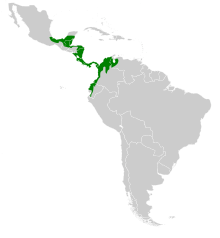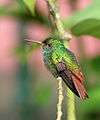Rufous-tailed hummingbird
| Rufous-tailed hummingbird | |
|---|---|
 | |
| Male | |
| Scientific classification | |
| Kingdom: | Animalia |
| Phylum: | Chordata |
| Class: | Aves |
| Order: | Trochiliformes |
| Family: | Trochilidae |
| Genus: | Amazilia |
| Species: | A. tzacatl |
| Binomial name | |
| Amazilia tzacatl (La Llave, 1833) | |
 | |
| Range of Amazilia tzacatl | |
The rufous-tailed hummingbird (Amazilia tzacatl) is a medium-sized hummingbird that breeds from east-central Mexico, through Central America and Colombia, east to western Venezuela and south through western Ecuador to near the border with Peru. The larger Escudo hummingbird from Isla Escudo de Veraguas in Panama is commonly considered a subspecies of the rufous-tailed hummingbird. This is a common to abundant bird of open country, river banks, woodland, scrub, forest edge, coffee plantations and gardens up to 1,850 m (6,070 ft).
Description
The adult rufous-tailed hummingbird is 10–12 cm (3.9–4.7 in) long and weighs approximately 5.2 g (0.18 oz). The throat is green (edged whitish in the female), the crown, back and flanks are green tinged golden, the belly is pale greyish, the vent and rump are rufous and the slightly forked tail is rufous with a dusky tip.
The almost straight bill is red with a black tip; the black is more extensive on the upper mandible, which may appear all black. Immatures are virtually identical to the female. The call is a low chut, and the male’s song is a whistled tse we ts’ we or tse tse wip tseek tse.
The female rufous-tailed hummingbird is entirely responsible for nest building and incubation. She lays two white eggs in a compact cup nest constructed from plant-fibre and dead leaves and decorated with lichens and mosses 1–6 m (3.3–19.7 ft) high on a thin horizontal twig. Incubation takes 15–19 days, and fledging another 20–26.
Diet
The food of this species is nectar, taken from a variety of flowers, including Heliconias and bananas. Like other hummingbirds, it also takes small insects as an essential source of protein. Rufous-tailed hummingbirds are very aggressive, and defend flowers and shrubs in their feeding territories. They are dominant over most other hummingbirds.
Gallery
 Rufous-tailed hummingbird
Rufous-tailed hummingbird Rufous-tailed hummingbird in Panama
Rufous-tailed hummingbird in Panama
References
- ↑ BirdLife International (2012). "Amazilia tzacatl". IUCN Red List of Threatened Species. Version 2013.2. International Union for Conservation of Nature. Retrieved 26 November 2013.
External links
| Wikimedia Commons has media related to Amazilia tzacatl. |
| Wikispecies has information related to: Amazilia tzacatl |
- "Rufous-tailed hummingbird media". Internet Bird Collection.
- Detailed Report w/Range Maps InfoNatura NatureServe
- Photo-Medium Res; Article chandra.as.utexas.edu–"Birds of Ecuador"
- Rufous-tailed hummingbird photo gallery at VIREO (Drexel University)
- Rufous-tailed hummingbird species account at NeotropicalBirds (Cornell University)
Bibliography
Stiles and Skutch, A guide to the birds of Costa Rica ISBN 0-8014-9600-4
Hilty, Birds of Venezuela by, ISBN 0-7136-6418-5
